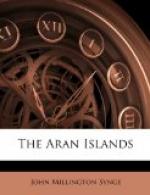When we started again, a small sail was run up in the bow, and we set off across the sound with a leaping oscillation that had no resemblance to the heavy movement of a boat.
The sail is only used as an aid, so the men continued to row after it had gone up, and as they occupied the four cross-seats I lay on the canvas at the stern and the frame of slender laths, which bent and quivered as the waves passed under them.
When we set off it was a brilliant morning of April, and the green, glittering waves seemed to toss the canoe among themselves, yet as we drew nearer this island a sudden thunderstorm broke out behind the rocks we were approaching, and lent a momentary tumult to this still vein of the Atlantic.
We landed at a small pier, from which a rude track leads up to the village between small fields and bare sheets of rock like those in Aranmor. The youngest son of my boatman, a boy of about seventeen, who is to be my teacher and guide, was waiting for me at the pier and guided me to his house, while the men settled the curagh and followed slowly with my baggage.
My room is at one end of the cottage, with a boarded floor and ceiling, and two windows opposite each other. Then there is the kitchen with earth floor and open rafters, and two doors opposite each other opening into the open air, but no windows. Beyond it there are two small rooms of half the width of the kitchen with one window apiece.
The kitchen itself, where I will spend most of my time, is full of beauty and distinction. The red dresses of the women who cluster round the fire on their stools give a glow of almost Eastern richness, and the walls have been toned by the turf-smoke to a soft brown that blends with the grey earth-colour of the floor. Many sorts of fishing-tackle, and the nets and oil-skins of the men, are hung upon the walls or among the open rafters; and right overhead, under the thatch, there is a whole cowskin from which they make pampooties.
Every article on these islands has an almost personal character, which gives this simple life, where all art is unknown, something of the artistic beauty of medieval life. The curaghs and spinning-wheels, the tiny wooden barrels that are still much used in the place of earthenware, the home-made cradles, churns, and baskets, are all full of individuality, and being made from materials that are common here, yet to some extent peculiar to the island, they seem to exist as a natural link between the people and the world that is about them.
The simplicity and unity of the dress increases in another way the local air of beauty. The women wear red petticoats and jackets of the island wool stained with madder, to which they usually add a plaid shawl twisted round their chests and tied at their back. When it rains they throw another petticoat over their heads with the waistband round their faces, or, if they are young, they use a heavy shawl like those worn in Galway. Occasionally other wraps are worn, and during the thunderstorm I arrived in I saw several girls with men’s waistcoats buttoned round their bodies. Their skirts do not come much below the knee, and show their powerful legs in the heavy indigo stockings with which they are all provided.




